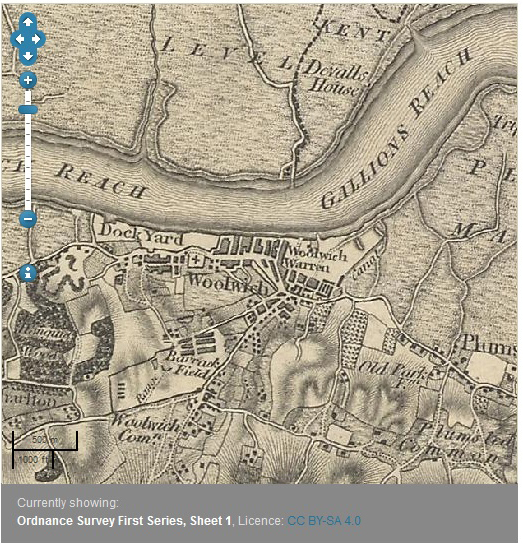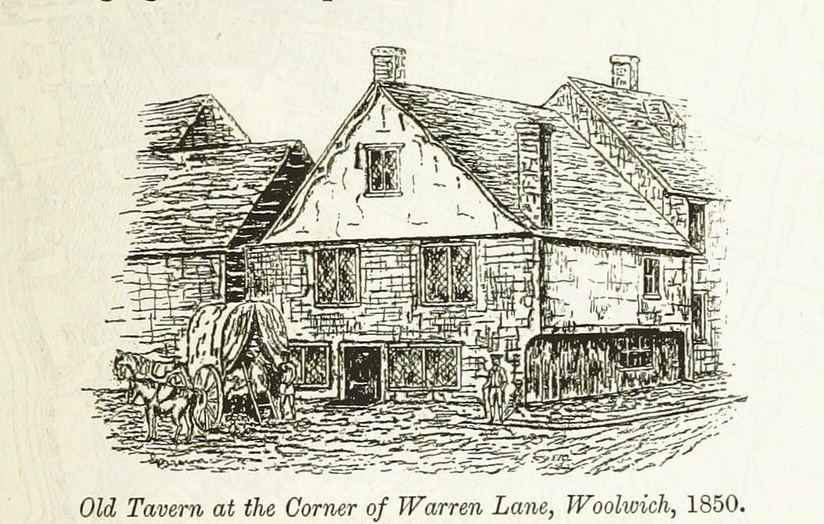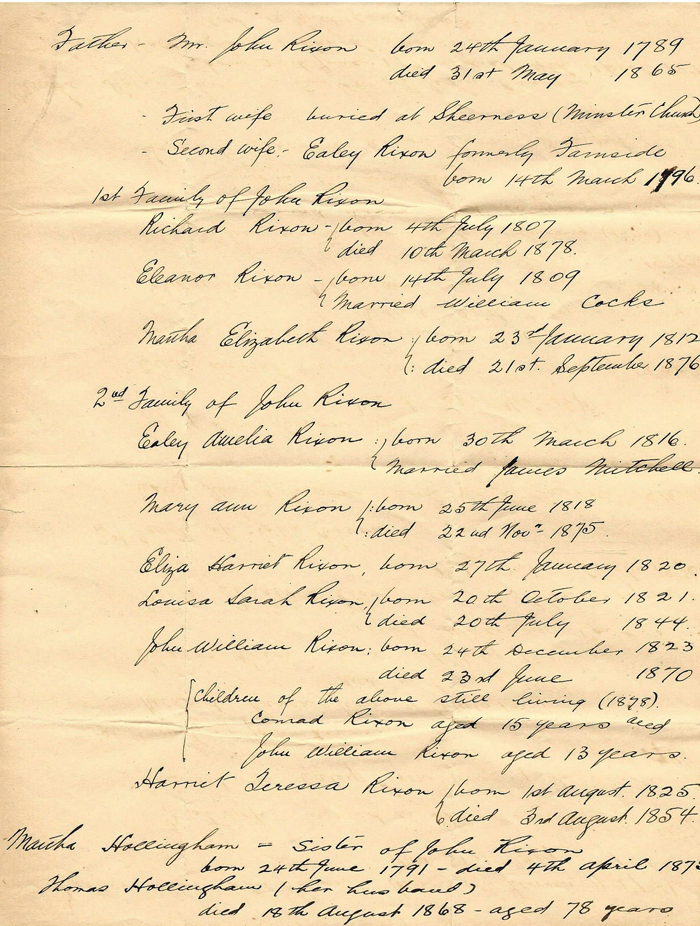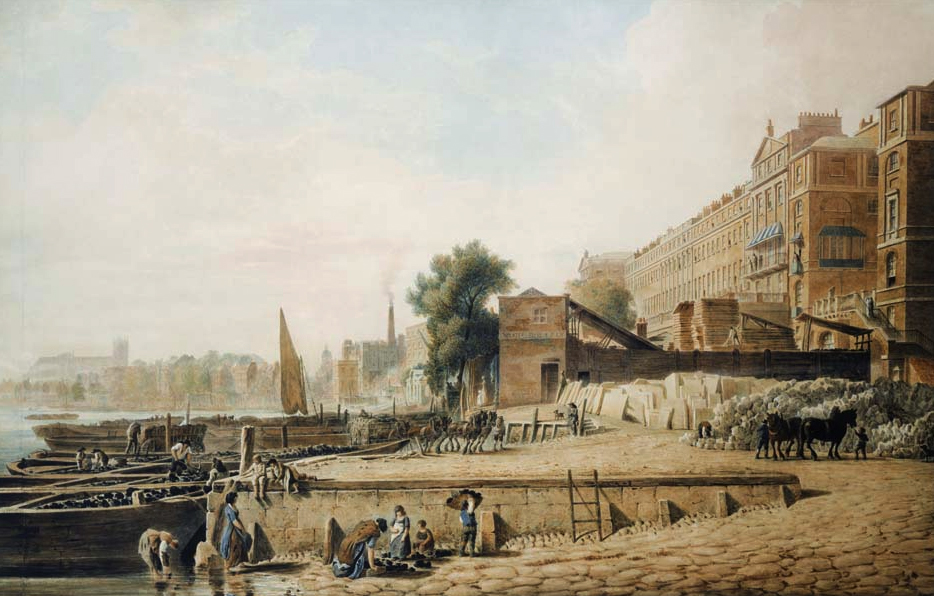My three-times grandfather Thomas Rixon (1793-1876) was born in Woolwich, England, moved to Canada as a young man and settled on a farm near Brighton, Ontario where he and his wife brought up their 11 children. I learned his name from notes my grandmother wrote on the back of a photo, but I knew nothing about his parents or siblings.
A search for Thomas Rixon on Ancestry.ca brought up the names of five children born to William Rixon and Martha Rixon and baptized at St. Mary Magdalene Church, Woolwich.1 They were: Martha, bap. 17 July 1791; Thomas, bap. 13 November 1793; James, bap. 17 January 1796; Eliza, 8 April, 1798; Robert, bap. 4 January 1801.

More research turned up the transcription of the gravestone of Wiiliam Rixon and Martha Rixon in Woolwich Churchyard. The monumental inscription reads: “Mrs Martha Rixon of this parish died 27 December 1817 aged 60 years. Mr William Rixon her husband died 3 November 1828 aged 81, and four of their children, viz Robert, William, Richard, Eliza.”2
Several Public Member Trees on Ancestry say that the father, William Rixon, was baptized on 15 Jan. 1748 at Kingsclere, Hampshire, the son of John Rixon and Mary.3 I have not found proof that this was Thomas’s father, but the age at death fits.
Identifying William’s wife Martha has been challenging. Most Rixon family trees on Ancestry say she was Martha Warden, but so far I have not found a record of this marriage.4 There is another possibility: a marriage between William Reekson and Martha Tyler, 29 March, 1784 at St. Mary Magdalene. According to www.freereg.org.uk, both the bride and the groom signed with a mark.5 Another public member tree on Ancestry suggests that William’s wife was Martha Yeomans, but this is most likely wrong.6
William’s occupation is unknown, but Woolwich, Kent, located on the Thames eight miles east of London, was home to the Royal Arsenal where military weapons were developed and tested, as well as a military academy and naval shipyard. The area around the dockyard, known as the Warren, consisted of workshops, warehouses, timber yards, barracks, and foundries. There were probably plenty of job opportunities in Woolwich, even if William was not in the military.7At the times of their deaths, William and Martha lived on Warren Lane, the town’s main road.8 The naval dockyards in Woolwich closed in 1869.

As for the Rixon children, there were probably eight of them: John b. 1787, Martha b. 1791, Thomas b. 1793; James b. 1796; Eliza b. 1798; and Robert b. 1801. There seem to have been two other children whose baptisms I have not found: William and Richard.
John, Martha, Thomas and James lived to adulthood while the others probably died young. Thomas and James settled in Upper Canada, while Martha and John remained in Woolwich. John became a coal merchant. In 1878, James’s son Thomas went to England to visit John’s son Richard, hoping to get a donation for a church bell. Thomas was interested in family history and his notes9 shine a light on the family’s past.
John Rixon (1787-1863). The 1841 census of England and Wales gave his age as 54, suggesting he was born in 1787.10 According to nephew Thomas Rixon from Canada, John was born 24 January 1789. His baptism is not available on Ancestry.
John married Eleanor Farris on 13 July 1806 in Plumstead, the parish next to Woolwich, and they had three children. After Eleanor died, he married Ealey Farnfield on 29 May 1815 in Woolwich. John and Ealey had six children.

In 1824, when he put his son Richard into an apprenticeship as a stationer,11 John was identified as a coal merchant. According to the 1851 census, he was one of the high commissioners for taxes for the county of Kent. At that time, John was living at Rectory Place, Woolwich along with his wife, daughter Eliza, son John (a bookbinder and deputy registrar of births and deaths, district of Woolwich), daughter Harriet and a servant. John Rixon, gentleman, died 31 May 1863 and when his will was probated, his effects were less than 5,000 pounds.12
Martha Rixon (1791-1875). In the note about his cousins, Thomas Rixon mentioned that John had a sister Martha. Baptized 17 July, 1791 at St. Mary Magdalene, she married Thomas Hollingham on 28 June, 1818 at St. Nicholas parish, in Plumstead. The 1851 census found Thomas, a shipwright, and Martha living at 17 Warren Lane, Woolwich. Perhaps this was her parents’ former home. Martha died in 1875, age 84.
Thomas Rixon (1793-1876) My direct ancestor was baptized at St. Mary Magdalene parish church on 13 November, 1793. He immigrated to Upper Canada as a young man and settled on a small piece of land in Sophiasburg Township, Price Edward County, on the shores of Lake Ontario. He married the girl next door, Elizabeth Thompson, in 1825 and they brought up 11 children. By 1861 the family had moved to Cramahe Township in neighbouring Northumberland County.
Thomas was counted in the 1851, 1861 and 1871 censuses, identifying himself either as a farmer or a carpenter. In 1861, the family lived in a modest single-story wood frame house.13 His wife and children were Methodists, but Thomas retained his Church of England faith.
James Rixon (1795-1870) James was baptized in Woolwich on 17 January, 1796 and probably came to Canada around 1820. He settled near Milton, a fertile farming area between Toronto and Hamilton, Ontario. He married Mary Davidson around 1822 and they had nine children.14 He died 9 February, 1870, age 74, and is buried along with his wife and several other family members in the Bronte Pioneer Cemetery.
Eliza (1798- ) Ancestry has a record of the baptism of Eliza, 8 April, 1798 and a burial record for Elizabeth Rixon, 5 July, 1799. This could be the Eliza listed on the family gravestone. There are questions or inconsistencies about the following three people:
Robert Rixon There is a baptismal record for Robert Rison, parents William Rison and Martha Rison, on 4 January 1801, St. Mary Magdalene, Woolwich. A transcription of The National Burial Index for England and Wales15 includes the burial of Robert Rixon on 6 January, 1811, however, his age is not included.
There may have been another Robert Rixon in Woolwich at that time. Ancestry has Robert Rixon’s marriage by licence to Sarah Mortimer, who signed the record with an X, on 1 October, 1811. Robert and Sarah had three children. Ancestry also shows a man named Robert Rixon died at age 37 in the poor house, Woolwich, 5 January, 1821;16 he would have been born around 1784. It is also possible that Robert was the first son and died very young and that later another son was given the same name.
William Rixon William is listed on the family grave, but with no birth or death dates. One of the member-submitted Rixon family trees on Ancestry gives his birthdate as 6 Nov. 1785, however, I have not seen an official source for this date. There is a burial record in Woolwich in 1813 for a William Rixon, age 43, but he would have been too old to be William’s and Martha’s son.17
Richard Rixon was buried in St. Mary Magdalene cemetery on 9 October 1796,but I have not found a baptism record for him and there was no indication whether the deceased was a child. With a smallpox epidemic in London that year, there were more than 30 burials in Woolwich churchyard in September and a similar number in October.
photo credits:
www.visionofbritain.org.uk
www,flickr.com/photos/britishlibrary
courtesy Janet Clark
Notes and footnotes:
The name Rixon was not uncommon in southeast England. It was sometimes spelled Rison, Rixson, Rickson or Rixen. I have not included the source of every fact in this article; if I have not noted otherwise, I found all the baptism, marriage and death dates and census information on Ancestry. I examined all available document images.
- St Mary Magdalene, Woolwich, Composite register: baptisms, burials, Jan 1779-Dec 1799, London, England, “Church of England Baptisms, Marriages and Burials, 1538-1812”, database, (www.ancestry.com: accessed 21 January 2017), entry for Thomas Rixon; citing “Church of England Parish Registers, 1538-1812. London, England: London Metropolitan Archives”.
- “A transcription of Vol’s 4 & 5 of Leland. L. Duncan’s manuscript notebook of Monumental Inscriptions for Woolwich typed up by Margaret Broomfield; Monumental Inscriptions Woolwich Churchyard M.I.s #s 451-903,” # 607, accessed Jan. 20, 2017, http://www.kentarchaeology.org.uk/Research/Libr/MIs/MIsWoolwich/MIsWoolwich451-903.htm
- England & Wales, Christening Index, 1530-1980 database, (www.ancestry.com: accessed 21 January 2017), entry for William Rixon; citing Genealogical Society of Utah, “British Isles Vital Records Index, 2nd Edition” Salt Lake City, Utah.
- I discovered a hint that someone named Martha Warden may have been in Woolwich in the 1780s: a Martha Warden married William Atkinson at Saint Martin in the Fields, Westminster, on 13 June 1780, and a William Atkinson was buried less than a month later, on 18 July 1780, at St. Mary Magdalene, Woolwich. Perhaps Martha’s first husband brought her from central London to Woolwich.
- A search of www.freereg.org.uk for William Rixon (with the soundex box ticked), marriage, Kent, 1780-1790, returned this result; accessed Jan. 22, 2017.
- Ancestry has an index to a marriage record of William Rixon, of Wateringbury, bachelor, and Martha Yeomans, married in Maidenstone, Kent in 1801. Given that my Rixons had all their children prior to 1801, it seems doubtful that Martha Yeomans was related.
- See Greenwich Royal Museums, Port Cities London, http://www.portcities.org.uk/london/server/show/ConNarrative.52/chapterId/779/Deptford-and-Woolwich-Londons-Royal-Dockyards.html. See also https://thamesfacingeast.wordpress.com/2013/04/13/exploring-royal-woolwich-dockyards/and http://hidden-london.com/gazetteer/woolwich/
- “London, England, Church of England Deaths and Burials, 1813-1980”, database, (www.ancestry.com, accessed 20 January 2017), entry for William Rixon; citing “Board of Guardian Records, 1834-1906 and Church of England Parish Registers, 1813-1906. London Metropolitan Archives, London”.
- “Public Member Trees”, database, (www.ancestry.com accessed 23 January 2017), entry for Thomas Rixon (1834-1882); undocumented family tree submitted by Janet Clark.
- “1841 England, Wales and Scotland Census Image”, www.findmypast.com, citing The National Archives, London, England.
- “London, England, Freedom of the City Admission Papers, 1681-1930”, database, (www.ancestry.com) accessed 8 Jan 2016, entry for Richard Rixon; citing “Freedom admissions papers, 1681– 1930. London, England: London Metropolitan Archives.”
- “England & Wales, National Probate Calendar (Index of Wills and Administrations), 1858-1966, 1973-1995,” database, (www.ancestry.com, accessed 8 January, 2017), entry for John Rixon 1863; citing “Principal Probate Registry. Calendar of the Grants of Probate and Letters of Administration made in the Probate Registries of the High Court of Justice in England. London, England.”
- “Census Returns For 1861; Roll: C-1055-1056, Library and Archives Canada; Ottawa, Ontario, Canada”; (www.Ancestry.com and The Church of Jesus Christ of Latter-day Saints, accessed 20 January 2017), entry for Thomas Rickson; citing “1861 Census of Canada.”
- Year: 1851; Census Place: Trafalgar, Halton County, Canada West (Ontario); Schedule: A; Roll: C_11726; Page: 150; Line: 32. digital image, (www.ancestry.com, accessed 10 January, 2017), entry for James Rixon; citing “1851 Census of Canada East, Canada West, New Brunswick, and Nova Scotia.”
- Woolwich and District Family History Society, “National Burial Index for England and Wales Transcription”, database, (www.findmypast.com, accessed 23 January 2017), entry for Robert Rixon.
- “London, England, Church of England Deaths and Burials, 1813-1980”, database, (www.Ancestry.com, accessed 22 January 2017,) entry for Robert Rixon; citing “Board of Guardian Records, 1834-1906 and Church of England Parish Registers, 1813-1906. London Metropolitan Archives, London”.
- Ancestry shows records at St. Mary Magdalene Parish Church, Woolwich, of a William Rixon, who drowned in 1813. His wife, Ann, was pregnant at the time and the baby, named William John, was born in March, 1814, son of the late seaman. According to the church record, this William was 43 when he died.

